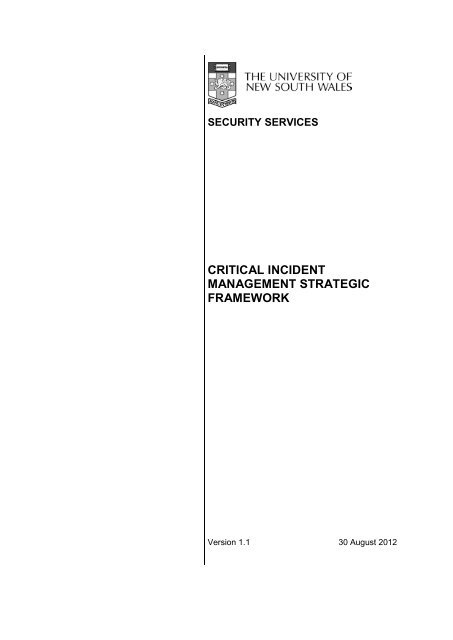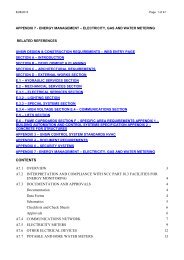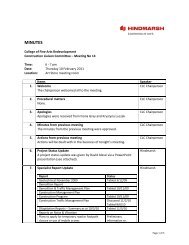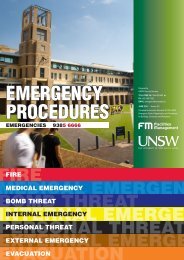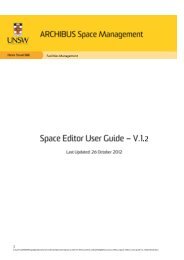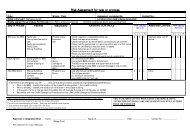critical incident management strategic framework - UNSW Facilities ...
critical incident management strategic framework - UNSW Facilities ...
critical incident management strategic framework - UNSW Facilities ...
Create successful ePaper yourself
Turn your PDF publications into a flip-book with our unique Google optimized e-Paper software.
EMERGENCY CONTACT LIS<br />
SECURITY SERVICES<br />
CRITICAL INCIDENT<br />
MANAGEMENT STRATEGIC<br />
FRAMEWORK<br />
Version 1.1 30 August 2012
Authority<br />
Version Authorisation Approval Date Effective Date<br />
1.0 Vice - President, Finance & Operations 25 June 2012 01 July 2012<br />
Document Control<br />
Review and History<br />
The content of this <strong>framework</strong> document is managed and controlled by Security Services who will<br />
ensure that this document is reviewed when any significant structural or operational changes<br />
necessitate it, and at least annually. Any suggestions for improvement or amendments to this<br />
document should be forwarded to emergency@unsw.edu.au.<br />
Version Reviewed by Approval Date Sections modified<br />
1.0 ET endorsed the paper 24 June 2012<br />
1.1<br />
Critical Incident Response<br />
Team<br />
Distribution and storage<br />
30 August 2012<br />
Hard copies of this document are distributed as follows:<br />
Appendix 2 - Key <strong>critical</strong> <strong>incident</strong><br />
responsibilities by position –<br />
Inclusion of 3 rd tier contacts for the<br />
Critical Incident Response team.<br />
Name Position Copy Number<br />
This document is publicly available on the <strong>UNSW</strong> website, which will contain the current version.<br />
The electronic version is stored in TRIM file no. 2012/02605. Printed versions, with the exceptions<br />
above, should be considered uncontrolled copies.<br />
Acknowledgements<br />
The support and assistance of the University of Canterbury and the University of Technology Sydney<br />
in developing this documentation is gratefully acknowledged.
Table of Contents<br />
Authority .......................................................................................... 2<br />
Document Control .............................................................................. 2<br />
Acknowledgements ............................................................................ 2<br />
1. Introduction .......................................................................... 4<br />
1.1 Purpose ................................................................................................... 4<br />
1.2 Principles ................................................................................................ 4<br />
1.3 Scope ...................................................................................................... 4<br />
1.4 Glossary .................................................................................................. 4<br />
2. Background ........................................................................... 4<br />
2.1 Definitions .............................................................................................. 5<br />
2.2 Critical <strong>incident</strong> phases ............................................................................ 6<br />
3. <strong>UNSW</strong> <strong>critical</strong> <strong>incident</strong> <strong>management</strong> system ............................... 7<br />
3.1 Planning .................................................................................................. 7<br />
Risk identification ............................................................................................. 7<br />
Identification of legal and other requirements ................................................... 7<br />
3.2 Implementation ....................................................................................... 8<br />
Roles and Responsibilities ................................................................................. 8<br />
Resources ....................................................................................................... 10<br />
Training, Awareness & Competency ................................................................. 11<br />
Communication ............................................................................................... 11<br />
Documentation and operational control ........................................................... 11<br />
3.3 Checking and review .............................................................................. 13<br />
Appendix 1 - Glossary ....................................................................... 14<br />
Appendix 2 – Roles & Responsibilities for Critical Incidents .................... 17<br />
Appendix 3 – Communications Tree – CRITICAL INCIDENT DECLARED ....... 25<br />
Page 3 of 25
1. Introduction<br />
1.1 Purpose<br />
This <strong>strategic</strong> <strong>framework</strong> is the overarching document that provides a ‘roadmap’ to the entire <strong>critical</strong><br />
<strong>incident</strong> (encompassing emergency and business continuity) <strong>management</strong> system at <strong>UNSW</strong>. This<br />
document:<br />
• defines the various terms in use;<br />
• articulates the broad approach to, and principles for, <strong>management</strong> of <strong>critical</strong><br />
<strong>incident</strong>s/emergencies and business continuity at <strong>UNSW</strong>;<br />
• outlines the processes in place to support the efficient <strong>management</strong> of the various phases<br />
of a <strong>critical</strong> <strong>incident</strong>, including related documents;<br />
• defines the roles and responsibilities relevant to <strong>critical</strong> <strong>incident</strong>/emergency <strong>management</strong><br />
and business continuity planning, including roles of committees and key individuals;<br />
• clarifies the interrelationship between various units within <strong>UNSW</strong> with responsibilities<br />
relating to <strong>critical</strong> <strong>incident</strong>/emergency <strong>management</strong> and business continuity planning and<br />
response, particularly Security Services, the Risk Management Unit, Health & Safety Unit and<br />
Media and Communications Unit; and<br />
• outlines the training which supports <strong>critical</strong> <strong>incident</strong>/emergency <strong>management</strong> and business<br />
continuity initiatives.<br />
1.2 Principles<br />
In the event of an emergency or <strong>critical</strong> <strong>incident</strong> at <strong>UNSW</strong>, the following principles should guide all<br />
actions:<br />
• Ensure the safety & wellbeing of students, employees and the general public (including<br />
following the cessation of the emergency). This principle overrides all others;<br />
• Ensure assets are protected and prevent harm to the environment;<br />
• Ensure that normal operations are maintained or resumed as quickly as possible;<br />
• Ensure that internal and public confidence is enhanced through a visible and professional<br />
response;<br />
• Ensure legislative compliance;<br />
• Optimise the financial implications; and<br />
• Undertake action to prevent reoccurrence, and to improve future responses.<br />
Critical <strong>incident</strong> <strong>management</strong> arrangements must be flexible enough to adapt to any type of<br />
<strong>incident</strong>, and provide sufficient support to allow for sound and rapid decision-making, particularly<br />
during the response phase.<br />
1.3 Scope<br />
The scope of this <strong>strategic</strong> <strong>framework</strong> extends to all Faculties, Divisions, Business Units, Research<br />
Centres, Controlled Entities and Affiliated Organisations located on a <strong>UNSW</strong> Campus.<br />
<strong>UNSW</strong> ADFA (Canberra) has site specific plans and procedures for Emergency Management &<br />
Business Continuity.<br />
1.4 Glossary<br />
Definitions of key terms used throughout this document are provided in Appendix 1.<br />
2. Background<br />
Page 4 of 25
2.1 Definitions<br />
A number of different terms are used in emergency <strong>management</strong> and business continuity<br />
documentation. To avoid potential for confusion the various terms are clearly defined below as they<br />
are used at <strong>UNSW</strong>. (For ease of reference, these definitions, and a number of others, are also<br />
included in the Glossary in Appendix 1).<br />
Term<br />
Incident<br />
Emergency<br />
Critical<br />
<strong>incident</strong> (OR<br />
crisis)<br />
Definition<br />
A localised event at <strong>UNSW</strong>, either accidental or deliberately caused, which may result<br />
in or have potential for injury, ill health, death, damage or other loss, and for which<br />
the response resources of <strong>UNSW</strong> are sufficient to cope, with no or minimal support<br />
from external agencies. The impact to University operations is minimal.<br />
An unplanned event that arises internally or externally, which may adversely affect<br />
persons or the <strong>UNSW</strong> Campus generally, and which requires an immediate and highly<br />
structured response from the University and Emergency Services to prevent or<br />
mitigate injury or death to persons, harm to the environment or damage to property.<br />
The impact on University operations can range from moderate to severe.<br />
An <strong>incident</strong> with sufficient impact to potentially overwhelm the usual coping skills of<br />
<strong>UNSW</strong>, and with potential to significantly harm the university during and after the<br />
immediate <strong>incident</strong>. A <strong>critical</strong> <strong>incident</strong> has a crucial or decisive aspect requiring a<br />
considered, coordinated and immediate response from senior <strong>management</strong> to<br />
prevent the situation from significantly worsening and to minimise the future<br />
ramifications. Critical <strong>incident</strong>s may be physical, such as major fires or chemical<br />
<strong>incident</strong>s, or they may be less tangible such as a political issue with potential to<br />
significantly damage the university’s reputation. The latter category is managed by<br />
the Vice-Chancellor and the Executive Team and is outside the scope of this<br />
<strong>framework</strong>.<br />
Disaster (OR<br />
catastrophe)<br />
Disruption<br />
event<br />
A <strong>critical</strong> <strong>incident</strong> may cause or have potential to cause any of the following:<br />
• A fatality, serious injury or other serious harm to staff, students or visitors<br />
• A significant impact on business operations and continuity<br />
• A threat to <strong>UNSW</strong>’s operations<br />
• A threat to the financial viability of <strong>UNSW</strong><br />
• Adverse attention by national media and government agencies or<br />
• Significant litigation to be threatened or initiated against <strong>UNSW</strong><br />
An occurrence causing widespread destruction and distress, often irremediable. A<br />
disaster is likely to be beyond the capacity of the prescribed statutory authorities and<br />
requires special mobilisation and organisation of resources other than those normally<br />
available to those authorities.<br />
An event that causes or is likely to cause a change from normal <strong>management</strong><br />
processes and operations by necessitating recovery processes and consequent<br />
direction of resources and <strong>management</strong> activity to achieve the recovery.<br />
‘Incidents’ occur at <strong>UNSW</strong> virtually on a daily basis and are managed in-house with minimal<br />
assistance from external organisations if required. Examples include theft, a minor water leak, minor<br />
fire or false alarm, minor injury, assault or power loss to a non-<strong>critical</strong> building. Incidents are<br />
commonly managed by staff or Security Services with minimal involvement from senior<br />
<strong>management</strong>. An <strong>incident</strong> becomes an emergency when the University response resources are<br />
insufficient to deal with the <strong>incident</strong> and additional external resources are required to manage and<br />
Page 5 of 25
coordinate the response. (This does not include <strong>incident</strong>s where emergency services attend as<br />
standard practice, such as attending false alarms).<br />
Critical <strong>incident</strong>s, which are considered to be equivalent to a crisis but will be referred to as ‘<strong>critical</strong><br />
<strong>incident</strong>s’ throughout this document, are those requiring a timely and coordinated response from<br />
senior <strong>management</strong>. Many events would be classed both as an emergency and a <strong>critical</strong> <strong>incident</strong>,<br />
such as major fires or explosions, natural disasters affecting campus, validated bomb threats,<br />
terrorist attack, shooter on campus or major hazardous material spills or leaks. However, an<br />
emergency does not necessarily become a <strong>critical</strong> <strong>incident</strong>. For example, a staff member having a<br />
heart attack is a medical emergency but is unlikely to become a <strong>critical</strong> <strong>incident</strong> unless there are<br />
spin-off effects (for example they are operating <strong>critical</strong> equipment at the time which causes some<br />
significant failure). Traffic accidents will often be defined as an <strong>incident</strong> if minor, or an emergency if<br />
someone is seriously hurt or killed, but is unlikely to become a <strong>critical</strong> <strong>incident</strong>.<br />
A <strong>critical</strong> <strong>incident</strong> will be officially declared as such by the Manager, Security Services or in their<br />
absence, their second in command or delegate. If an <strong>incident</strong> is escalated to a <strong>critical</strong> <strong>incident</strong>, the<br />
persons managing the event internally will also increase in seniority. If an <strong>incident</strong> is declared a<br />
<strong>critical</strong> <strong>incident</strong>, an Incident Controller will be established for the duration of the immediate<br />
<strong>incident</strong>, supported by a Critical Incident Response Team (CIRT) and the Management Recovery<br />
Team (MRT), which are invoked until such time as the response and recovery activities respectively<br />
are substantially completed. These teams will be discussed further under Section 3.2.<br />
2.2 Critical <strong>incident</strong> phases<br />
<strong>UNSW</strong> considers that there are six phases of a <strong>critical</strong> <strong>incident</strong> or emergency:<br />
1. Risk identification & assessment – where risks are considered, based on site inspections and<br />
experiences both on and off campus; and then prioritised based on their potential<br />
consequence and likelihood.<br />
2. Reduction – measures are put in place to reduce the likelihood of adverse consequences<br />
from risks, either by reducing their potential magnitude of impact or their likelihood. (These<br />
measures may be enough to prevent an <strong>incident</strong> from escalating into a <strong>critical</strong> <strong>incident</strong>, for<br />
example).<br />
3. Readiness (or preparedness)– putting in place contingency measures, including resources<br />
and services, to ensure that if a risk does eventuate that it can be managed efficiently, or at<br />
least coped with (for example, ensuring that adequate, functioning alarms and fire-fighting<br />
equipment is held).<br />
4. Response – the actions taken in anticipation of, during and immediately after an emergency<br />
or <strong>critical</strong> <strong>incident</strong> to ensure that its effects are minimised and that people affected are given<br />
immediate relief and support.<br />
5. Recovery (and continuity) – the coordinated process of supporting the reconstruction of<br />
physical infrastructure and restoration of emotional, social, economic and physical<br />
wellbeing.<br />
6. Review – a systematic and periodic process of evaluation by top <strong>management</strong> of the<br />
effectiveness, adequacy and ongoing suitability of the <strong>critical</strong> <strong>incident</strong> <strong>management</strong> system.<br />
This should take into account stakeholder feedback and the learnings from drills or <strong>critical</strong><br />
<strong>incident</strong>s which have occurred at <strong>UNSW</strong> or comparable organisations, and should entail the<br />
allocation of additional resources if required.<br />
A <strong>critical</strong> <strong>incident</strong> <strong>management</strong> system encompasses risk <strong>management</strong>, emergency <strong>management</strong><br />
and business continuity processes, which will overlap to varying degrees.<br />
Page 6 of 25
3. <strong>UNSW</strong> <strong>critical</strong> <strong>incident</strong> <strong>management</strong> system<br />
Given the wide-ranging nature of operations at <strong>UNSW</strong>, the large number of staff, students and<br />
visitors and the geographic spread of our facilities, the <strong>critical</strong> <strong>incident</strong>/emergency <strong>management</strong> and<br />
business continuity <strong>framework</strong> is complex and involves a number of stakeholders in its development<br />
and implementation.<br />
In broad terms, the key elements of the <strong>management</strong> system are as follows:<br />
• Planning – encompassing the identification of risks and legislative requirements and<br />
development of <strong>strategic</strong> plans to minimise risk and improve processes<br />
• Implementation – encompassing the allocation of roles and responsibilities; allocation of<br />
resources; development of communication processes; training; documentation and<br />
development of operational control processes<br />
• Checking and review –by top <strong>management</strong> to ensure that this <strong>framework</strong> is adequate and<br />
effective. This should occur at least annually, and more often if required after each <strong>critical</strong><br />
<strong>incident</strong> as part of the debriefing process.<br />
These are discussed in more detail below.<br />
3.1 Planning<br />
Planning for emergencies and subsequent business continuity processes requires an understanding<br />
of key risks and strategies for mitigation, as well as relevant legislative and other key requirements,<br />
to inform the development of relevant plans.<br />
Risk identification<br />
Key areas of risk relating to emergency <strong>management</strong> are identified by individual faculties and<br />
divisions/business units in the development of Business Impact Assessments, which are updated<br />
each year. The process for establishing these documents is outlined in the Business Continuity<br />
Management Handbook.<br />
A high-level business risk register is maintained by the Risk Management Unit and a risk register<br />
covering OHS risks for the whole of <strong>UNSW</strong> is under development by the Health and Safety Unit.<br />
Identification of legal and other requirements<br />
The Emergency Coordinator in Security Services, Director of Risk Management and Manager Health<br />
and Safety Unit periodically review relevant legislative requirements and update <strong>UNSW</strong><br />
documentation and processes as required to ensure compliance.<br />
Key legislation which informs the development of <strong>UNSW</strong> documents and processes include:<br />
• Work Health and Safety Act 2011 (NSW)<br />
• Work Health and Safety Regulation 2011 (NSW)<br />
Page 7 of 25
Particularly relevant Australian Standards include:<br />
• AS/NZS ISO 31000:2009 Risk <strong>management</strong> - Principles and guidelines<br />
• AS/NZS 4801:2001 Occupational health and safety <strong>management</strong> systems – Specification with<br />
guidance for use<br />
• AS 3745:2010 Planning for emergencies in facilities<br />
• AS 1851:2005 Maintenance of fire protection systems and equipment<br />
• AS5050:2010 Business Continuity – managing disruption related risk<br />
3.2 Implementation<br />
Roles and Responsibilities<br />
A number of groups and individuals play key roles relating to <strong>management</strong> of <strong>critical</strong> <strong>incident</strong>s. These<br />
are described in more detail below.<br />
Management Recovery Team<br />
Governance of, and <strong>strategic</strong> input to, <strong>critical</strong> <strong>incident</strong>/emergency <strong>management</strong> and business<br />
continuity is provided by the Management Recovery Team, comprised primarily of university<br />
executive. This team is officially invoked whenever a <strong>critical</strong> <strong>incident</strong> is declared, but also will meet<br />
periodically, nominally six-monthly, to discuss the planning arrangements in place, the adequacy of<br />
the existing system and resources, and to undertake relevant professional development as required.<br />
This group is chaired by the Vice - President Finance and Operations, and in their absence, the Vice -<br />
President University Services. Other team members are listed in Appendix 2.<br />
Critical Incident Response Team<br />
In the event of a <strong>critical</strong> <strong>incident</strong>, a Critical Incident Response Team will be established to manage<br />
the immediate <strong>incident</strong> response and limit loss of life, harm and property damage. Leading this team<br />
will be the Incident Controller, supported closely by several senior staff from key operational areas.<br />
The Incident Controller will typically be the Director, <strong>Facilities</strong> Management, and in their absence,<br />
the Associate Director Campus Services. Other members are listed in Appendix 2. The Incident<br />
Controller is delegated with the authority to issue instructions to all other staff during the <strong>critical</strong><br />
<strong>incident</strong> period. However, if external emergency services attend they will assume overall<br />
<strong>management</strong> responsibility for the <strong>incident</strong> and their instructions would override the Incident<br />
Controller if there were conflicting instructions.<br />
The Critical Incident Response Team and Management Recovery Team will work closely together in<br />
the event of a <strong>critical</strong> <strong>incident</strong>. A schematic showing the different focus of each group is included in<br />
Figure 1 on the following page.<br />
Page 8 of 25
Figure 1 – <strong>UNSW</strong> Critical Incident Response Organisation Structure*<br />
Emergency Control Organisation/s<br />
• Immediate response to <strong>critical</strong> <strong>incident</strong> (eg managing<br />
evacuations, first aid etc) until additional support arrives<br />
• Provide information to CIRT as required<br />
Vice Chancellor<br />
• Provide public assurances as advised by<br />
MRT<br />
Critical Incident Response Team (CIRT)<br />
Focus on immediate <strong>incident</strong> response to limit loss of life, harm and property damage<br />
Incident Controller<br />
(Director <strong>Facilities</strong> Management; alternate A/D Campus Services)<br />
• Assess <strong>incident</strong> and manage the response<br />
• Manage Critical Incident Response Team<br />
• Inform Management Recovery Team (primary briefings)<br />
Security/ Intelligence<br />
(Manager Security, alternate 2IC or delegate)<br />
• Liaison with Emergency Services and<br />
other agencies<br />
• Liaison with ECOs<br />
• Manage and supervise ground resources<br />
(security)<br />
• Analyse information received and project<br />
event scenarios<br />
• Maintain <strong>incident</strong> log<br />
• Follow up information requests and<br />
personnel as required<br />
• CIRT administration functions<br />
• Inform MRT (secondary briefings)<br />
• Inform the Incident Controller<br />
Building Operations/<br />
Logistics<br />
(A/D Asset Mgt; alternate<br />
Manager Maintenance)<br />
• Determine and request<br />
additional required<br />
resources<br />
• Manage and supervise<br />
ground resources (FM<br />
maintenance)<br />
• Service and support<br />
<strong>incident</strong> response<br />
locations and facilities<br />
• Inform the Incident<br />
Controller<br />
Health & Safety<br />
(Manager Health &<br />
Safety, alternate<br />
delegate Health &<br />
Safety Unit)<br />
• Monitor events<br />
& flag issues<br />
• Feed<br />
information to<br />
Security/Intellige<br />
nce<br />
• Inform the<br />
Incident<br />
Controller<br />
Management Recovery Team (MRT)<br />
Chair: Vice - President Finance & Operations,<br />
alternate Vice - President University Services<br />
Focus on communications and recovery by:<br />
• Reviewing the current status of the <strong>critical</strong><br />
<strong>incident</strong> as briefed by the Incident Controller<br />
• Supporting response needs as requested by<br />
the Incident Controller<br />
• Coordinating and preparing communications<br />
(includes internal and external advisories and<br />
bulletins, media releases)<br />
• Overseeing the transfer of responsibility for<br />
the recovery phase of the <strong>incident</strong> and<br />
ensuring the allocation of any resources<br />
required (physical or human)<br />
• Ensuring the appropriate level of ongoing<br />
care, counselling and medical support is<br />
provided.<br />
• Considering public and any family<br />
implications in relation to the <strong>incident</strong><br />
• Addressing any legal, financial, insurance,<br />
accountability or compliance issues in<br />
relation to the <strong>incident</strong><br />
• Enabling and contributing to a review process<br />
and determining any subsequent change in<br />
policy, procedures or physical structures<br />
• Advise Vice-Chancellor<br />
* Refer to Appendix 2 for additional detail about group composition and alternate membership<br />
Page 9 of 25
Emergency Control Organisations<br />
In addition, across the University there are a number of Emergency Control Organisations (ECOs),<br />
which comprises volunteers from faculties, business units and affiliated organisations unique to a<br />
building. Each ECO is responsible for managing the initial response to an emergency, particularly<br />
evacuations if required or administration of first aid, until other support arrives, including Security<br />
Services and external emergency services. ECOs typically meet on a six monthly basis to discuss<br />
relevant matters and undertake training as required.<br />
There are currently almost 60 separate ECOs across the campus. Details can be found at the<br />
following site (zpass required):<br />
http://www.facilities.unsw.edu.au/safety-security/emergency-<strong>management</strong>/emergency-controlorganisation-eco-teams/<br />
An individual staff member/s may assume different roles during and following a <strong>critical</strong><br />
<strong>incident</strong>/emergency, depending on the nature of the event. More detailed information about roles<br />
and responsibilities is included in Appendix 2.<br />
Emergency Services (external agencies)<br />
The role that will be assumed by the various emergency agencies is outlined in Appendix 2.<br />
Resources<br />
In the event of an emergency where it is required, the Emergency Operations Centre (EOC), a central<br />
command centre for <strong>UNSW</strong> and external agencies to control and coordinate an emergency<br />
operation will be used. The primary location on campus which has been established is Committee<br />
Room 4 (G04) of the Chancellery (C22).<br />
The secondary location on campus is the Basement, Red Centre Building Security Office.<br />
Should a <strong>critical</strong> <strong>incident</strong> extend across the whole <strong>UNSW</strong> Kensington Campus the University would<br />
establish it’s EOC at the Randwick SES Headquarters which has an active Emergency Operations<br />
Centre.<br />
The EOC contains supplies and equipment which will be of use in the event of a <strong>critical</strong> <strong>incident</strong>.<br />
Security Services also maintain equipment which can be used in the event of an emergency.<br />
The Management Recovery Team will ensure that adequate resources can be obtained in the event<br />
of a <strong>critical</strong> <strong>incident</strong>.<br />
For major events which place significant stress upon the university’s resources, support may be<br />
sought from other universities either within Sydney or elsewhere.<br />
Page 10 of 25
Training, Awareness & Competency<br />
<strong>UNSW</strong> will conduct at least one emergency drill in each building per year to assess staff and student<br />
awareness in emergencies. These drills are managed by Security Services with coordination by the<br />
Emergency Coordinator.<br />
An annual tabletop exercise relating to the Business Impact Assessments and Business Unit Recovery<br />
Plan is also conducted with Faculty/Divisional units where emergency procedures are practised. In<br />
addition, all staff and students are encouraged to review the Emergency Procedure Flipcharts which<br />
are distributed across campus buildings. This training is coordinated and run by the Risk<br />
Management Unit.<br />
The University provides training to all members of the Emergency Control Organisations as they<br />
assume their roles. Chief Wardens and deputies undertake a one day face-to-face training program<br />
while other wardens undertake a three hour training session which includes an online component<br />
and practical fire extinguisher training. Refresher training is available to wardens upon request. First<br />
Aid officers undertake formal first aid training with a refresher required every three years. This<br />
training is arranged and coordinated by the Emergency Coordinator.<br />
It is also planned that training of ECOs in building-specific aspects and requirements will commence<br />
rollout in 2012.<br />
Communication<br />
In the event that a <strong>critical</strong> <strong>incident</strong> is declared, all internal communications and notifications shall be<br />
coordinated by the Incident Controller. Until that point, the Manager Security or their delegate is<br />
responsible for coordinating all internal communications. Where possible, and if time allows, the<br />
<strong>UNSW</strong> Incident Controller and Manager Security Services will liaise with Director Media and<br />
Communications before staff and student communications are sent. A communications tree has<br />
been developed to minimise the risk of key stakeholders not receiving notification, and this is<br />
included in Appendix 3.<br />
All external communications (other than with Emergency Services) and particularly dealings with the<br />
Media will be managed by the Director, Media & Communications or their delegate. Updates on the<br />
University website and emails to all staff (if necessary) shall also be via this Unit.<br />
In addition, there is an SMS service (<strong>UNSW</strong>alert) to notify registered subscribers of an emergency. All<br />
staff and students may register to receive these alerts via their my<strong>UNSW</strong> accounts (under Personal<br />
Details – Phone, with the option to OPT IN for the Emergency SMS Service). There are currently<br />
approximately 5,500 subscribers who receive one test SMS each year as well as any actual<br />
emergency SMS’s.<br />
Documentation and operational control<br />
A number of documents articulating the controls in place, including plans and procedures, support<br />
this <strong>strategic</strong> <strong>framework</strong>. The interrelationships between these documents are illustrated in Figure 2<br />
on the following page.<br />
Page 11 of 25
Figure 2 – <strong>UNSW</strong> emergency <strong>management</strong> and business continuity documentation (grouped by target audience) (current as at 10 April 2012)<br />
Legend: Responsibility for production<br />
<strong>Facilities</strong> Mgt<br />
Risk Mgt<br />
IT<br />
Health & Safety<br />
Unit<br />
<strong>UNSW</strong> Health<br />
Services<br />
Emergency Management<br />
Plan<br />
Critical Incident Management<br />
Strategic Framework<br />
Business Continuity Mgt<br />
Handbook<br />
Security Services Standing<br />
Instructions & Procedures<br />
Security Control Room<br />
Emergency Action Guide<br />
Code Black Lockdown<br />
Procedures – Building<br />
Emergency<br />
Emergency Control<br />
Organisation<br />
Handbook<br />
Building-specific<br />
Response Plans<br />
(under<br />
development)<br />
Emergency<br />
procedures<br />
(flipcharts)<br />
Emergency<br />
website<br />
Pandemic<br />
Management<br />
Plan<br />
Management<br />
Recovery Team<br />
IT<br />
Recovery<br />
Plan<br />
IT<br />
<strong>UNSW</strong><br />
Business<br />
Impact<br />
Analysis<br />
Management<br />
Recovery Plan<br />
Management<br />
Recovery Team<br />
Faculty/Business<br />
Unit Business<br />
Impact Analyses<br />
Business Unit<br />
Recovery Plans<br />
Faculty/Business<br />
Unit Reps<br />
Emergency Contacts<br />
Register<br />
Security Services<br />
Emergency Control<br />
Organisation/s<br />
Campus<br />
community<br />
Health & Safety<br />
Management System<br />
Risk Management<br />
Policy<br />
Campus Community<br />
Page 12 of 25
3.3 Checking and review<br />
Upon the cessation of the response component of a <strong>critical</strong> <strong>incident</strong>, and after the recovery activities<br />
are substantially underway, a debrief will be held to discuss the successes and weaknesses in the<br />
preparedness and response. Lessons learnt will inform actions to continuously improve this <strong>strategic</strong><br />
<strong>framework</strong> and its various components.<br />
Executive <strong>management</strong>, via the Management Recovery Team, meet periodically as required but at<br />
least every six months, to review the effectiveness, adequacy and suitability of the <strong>critical</strong> <strong>incident</strong><br />
<strong>management</strong> system.<br />
Page 13 of 25
Appendix 1 - Glossary<br />
Business continuity<br />
<strong>management</strong> (BCM)<br />
Business continuity<br />
plan (BCP)<br />
Control<br />
Critical Incident (OR<br />
Crisis)<br />
Critical Incident<br />
Response Team<br />
(CIRT)<br />
Disaster<br />
District Emergency<br />
Operations<br />
Controller (DEOCON)<br />
Business continuity <strong>management</strong> provides for the availability of processes and<br />
resources in order to ensure the continued achievement of <strong>critical</strong> objectives<br />
and business processes. Business continuity <strong>management</strong> (BCM) describes a<br />
whole of business approach to ensure <strong>critical</strong> business processes (functions) can<br />
be maintained, or restored in a timely fashion, in the event of material<br />
disruptions arising from internal or external events. Its purpose is to minimise<br />
the financial, legal, reputational and other material consequences arising from<br />
the disruption.<br />
A collection of validated written procedures and information that is developed,<br />
compiled and maintained in readiness for use to recover <strong>critical</strong> business<br />
processes within defined timeframes in the event of a disruptive event.<br />
Business continuity planning is a term typically used to refer to those activities<br />
associated with preparing documentation to assist in the continuing availability<br />
of property, people and assets.<br />
The overall direction of the activities, agencies, organisations or individuals<br />
concerned.<br />
An <strong>incident</strong> with sufficient impact to potentially overwhelm the usual coping<br />
skills of <strong>UNSW</strong>, and with potential to significantly harm the university during and<br />
after the immediate <strong>incident</strong>. A <strong>critical</strong> <strong>incident</strong> has a crucial or decisive aspect<br />
requiring a considered, coordinated and immediate response from senior<br />
<strong>management</strong> to prevent the situation from significantly worsening and to<br />
minimise the future ramifications. Critical <strong>incident</strong>s may be physical, such as<br />
major fires or chemical <strong>incident</strong>s, or they may be less tangible such as a political<br />
issue with potential to significantly damage the university’s reputation.<br />
A <strong>critical</strong> <strong>incident</strong> may cause or have potential to cause any of the following:<br />
• A fatality, serious injury or other serious harm to staff, students or<br />
visitors<br />
• A significant impact on business operations and continuity<br />
• A significant impact on the image or reputation of <strong>UNSW</strong><br />
• A threat to <strong>UNSW</strong>’s operations;<br />
• A threat to the financial viability of <strong>UNSW</strong><br />
• Adverse attention by national media and government agencies; or<br />
• Significant litigation to be threatened or initiated against <strong>UNSW</strong><br />
The team responsible for overall <strong>management</strong> of the response phase of a <strong>critical</strong><br />
<strong>incident</strong>, as well as providing operational and technical support and advice for<br />
the risk identification, reduction, readiness, recovery and review phases. This<br />
team closely supports the Incident Controller, who leads this team, during the<br />
response phase.<br />
An occurrence causing widespread destruction and distress, often irremediable.<br />
A disaster is likely to be beyond the capacity of the prescribed statutory<br />
authorities and requires special mobilisation and organisation of resources other<br />
than those normally available to those authorities.<br />
The District Emergency Operations Controller (DEOCON), who is to be a police<br />
officer holding the position of Region Commander, is appointed by the<br />
Commissioner of Police.<br />
Page 14 of 25
Disruption event<br />
Duty Operations<br />
Inspector (DOI)<br />
Emergency<br />
Emergency Control<br />
Organisation (ECO)<br />
Emergency<br />
Management Plan<br />
Emergency<br />
Operations Centre –<br />
(EOC)<br />
Emergency Services<br />
Evacuation<br />
Incident<br />
Incident Controller<br />
Local Emergency<br />
Operations<br />
Controller (LEOCON)<br />
An event that causes or is likely to cause a change from normal <strong>management</strong><br />
processes and operations by necessitating recovery processes and consequent<br />
direction of resources and <strong>management</strong> activity to achieve the recovery.<br />
Duty Operations Inspector which is the Senior Police officer on duty at time of an<br />
<strong>incident</strong> at the Sydney Police Centre VKG. Goulburn St Darlinghurst.<br />
An unplanned event that arises internally or externally, which may adversely<br />
affect persons or the <strong>UNSW</strong> Campus generally, and which requires an immediate<br />
and highly structured response from the University and Emergency Services to<br />
prevent or mitigate injury or death to persons, harm to the environment or<br />
damage to property. The impact on University operations can range from<br />
moderate to severe.<br />
An event, actual or imminent, which endangers or threatens to endanger life,<br />
property or the environment and which requires an urgent, significant and<br />
coordinated response, typically involving the use of external Emergency Services.<br />
The event may arise internally or from external sources. The ultimate impact to<br />
the University can range from moderate to severe.<br />
A location-specific team of volunteer staff who will initially manage the response<br />
to emergency situations, including evacuations and first aid, until additional<br />
support arrives on the scene<br />
A plan that describes the arrangements for the conduct of emergency<br />
<strong>management</strong> operations and response at <strong>UNSW</strong>, and listing agreed roles,<br />
responsibilities and actions of agencies which have response and recovery<br />
functions for emergencies within the area covered by this <strong>framework</strong>.<br />
The designated centre of communication established within <strong>UNSW</strong>, from which<br />
the emergency controller can control and coordinate operations during an<br />
emergency, and where liaison officers from combat agencies and participating<br />
organisations are located.<br />
Emergency Services include, but are not limited to; the NSW Police, Fire &<br />
Rescue NSW, NSW Ambulance Service and State Emergency Services.<br />
The planned relocation of persons from dangerous or potentially dangerous<br />
areas to safer areas and eventual return.<br />
A localised event at <strong>UNSW</strong>, either accidental or deliberately caused, which may<br />
result in or have potential for injury, ill health, death, damage or other loss, and<br />
for which the response resources of <strong>UNSW</strong> are sufficient to cope, with no or<br />
minimal support from external agencies. The impact to University operations is<br />
minimal.<br />
The person assuming overall responsibility for the response phase of a <strong>critical</strong><br />
<strong>incident</strong>. This person has the authority to direct others, including senior staff,<br />
once a <strong>critical</strong> <strong>incident</strong> has been declared. Control of the situation may be<br />
assumed by external Emergency Services in some instances, in which case the<br />
Incident Controller will assume primarily a coordination and liaison role.<br />
The Local Emergency Operations Controller (LEOCON) is appointed for a local<br />
government area by the District Emergency Operations Controller (DEOCON).<br />
The person appointed must be a police officer stationed within the district in<br />
which the local government area is located and, in the opinion of the DEOCON,<br />
must have experience in emergency <strong>management</strong>.<br />
Page 15 of 25
Management<br />
Recovery Team<br />
(MRT)<br />
Readiness (OR<br />
preparedness)<br />
Recovery<br />
Reduction (of risk)<br />
Response<br />
Review<br />
Risk<br />
Risk identification<br />
and assessment<br />
Tabletop exercises<br />
The University’s Management Recovery Team (MRT) serves as the central body<br />
for coordinating University-wide business continuity efforts in the event of a<br />
<strong>critical</strong> <strong>incident</strong>.<br />
Putting in place contingency measures, including resources and services, to<br />
ensure that if a risk does eventuate that it can be managed efficiently, or at least<br />
coped with (for example, ensuring that adequate, functioning alarms and firefighting<br />
equipment is held)<br />
The coordinated process of supporting the reconstruction of physical<br />
infrastructure and restoration of emotional, social, economic and physical<br />
wellbeing<br />
Measures put in place to reduce the likelihood of adverse consequences from<br />
risks, either by reducing their potential magnitude of impact or their likelihood.<br />
Actions taken in anticipation of, during, and immediately after an emergency or<br />
<strong>critical</strong> <strong>incident</strong> to ensure that its impact and consequences are minimised, and<br />
that people affected are promptly provided appropriate relief and support.<br />
A systematic and periodic process of evaluation by top <strong>management</strong> of the<br />
effectiveness, adequacy and ongoing suitability of the <strong>critical</strong> <strong>incident</strong><br />
<strong>management</strong> system. This should take into account stakeholder feedback and<br />
the learnings from drills or <strong>critical</strong> <strong>incident</strong>s which have occurred at <strong>UNSW</strong> or<br />
comparable organisations, and should entail the allocation of additional<br />
resources if required.<br />
A concept used to describe the likelihood and degree of adverse consequences<br />
arising from the interaction of hazards, communities and the environment.<br />
Where risks are considered, based on site inspections and experiences both on<br />
and off campus; and then prioritised based on their potential consequence and<br />
likelihood<br />
An activity simulating an emergency event through activation of alarms and<br />
deployment of personnel, in order to —<br />
(a) review/test the planning process and procedures;<br />
(b) Identify needs and planning inadequacies;<br />
(c) demonstrate capabilities and communication; and<br />
(d) foster working together as a team.<br />
Page 16 of 25
Appendix 2 – Roles & Responsibilities for Critical Incidents<br />
Membership of Critical Incident Response Team<br />
Principal Member Alternate Member Third Tier Member<br />
Director, <strong>Facilities</strong> Management<br />
Associate Director, Campus Services, <strong>Facilities</strong><br />
Management<br />
Associate Director, Planning & Development<br />
Associate Director, Asset Management Manager, Maintenance Senior Client <strong>Facilities</strong> Managers<br />
Manager, Security Services Deputy Manager, Security Services Emergency Coordinator<br />
Manager, Health & Safety Director, HR Health & Safety Coordinator, Faculty of Science<br />
Additional resources, such as but not limited to Faculty Deans, General Managers or Heads of Schools will be drawn upon on a case-by-case basis.<br />
Membership of Management Recovery Team<br />
Principal Member<br />
Vice - President, Finance & Operations (Chair)<br />
Director, <strong>Facilities</strong> Management<br />
Director, IT at <strong>UNSW</strong><br />
PVC Students<br />
Director, HR<br />
Director, Communications<br />
Manager, Security Services<br />
Director, Risk Management<br />
Director <strong>UNSW</strong> Health Service (<strong>UNSW</strong> Primary Flu Manager)<br />
Alternate Member (if principal member unavailable)<br />
Vice - President, University Services<br />
Associate Director, Campus Services, <strong>Facilities</strong> Management<br />
Director, IT Customer Services<br />
Director, Student Life and Learning<br />
Manager, Health & Safety<br />
Deputy Director Communications/ Executive Producer <strong>UNSW</strong>TV<br />
Deputy Manager, Security Services (or delegate of Manager, Security)<br />
TBA<br />
TBA<br />
Page 17 of 25
Key <strong>critical</strong> <strong>incident</strong> responsibilities by position<br />
Position title<br />
Associate<br />
Director, Asset<br />
Management<br />
Critical<br />
<strong>incident</strong> role<br />
Member of<br />
CIRT?<br />
Member of<br />
MRT?<br />
Advisor, CIRT Y N • Maintain building/<br />
infrastructure assets<br />
efficiently to minimise risk<br />
• Maintain relevant<br />
contingency equipment<br />
(eg fire systems, signage)<br />
Key responsibilities<br />
Prior During After<br />
• Providing technical<br />
advice on<br />
building/infrastructure<br />
assets<br />
• Organising immediate<br />
responses as required<br />
• Managing<br />
building/infrastructure asset<br />
recovery processes<br />
Associate<br />
Director, Campus<br />
Services<br />
Alternate<br />
Incident<br />
Controller<br />
Y<br />
(alternate)<br />
Y<br />
(alternate)<br />
• Support Director <strong>Facilities</strong> Management as required; act as alternate for Director <strong>Facilities</strong><br />
Management when they are unavailable<br />
• Oversee the operations of Security Services; ensure that appropriate contingency measures<br />
are in place and KPTs are achieved<br />
Associate<br />
Director, Planning<br />
& Development<br />
Business<br />
Continuity<br />
Management<br />
Coordinator<br />
Backup<br />
Incident<br />
Controller<br />
Y<br />
(alternate)<br />
N • Support Director <strong>Facilities</strong> Management as required; act as backup for Director <strong>Facilities</strong><br />
Management or Associate Director, Campus Services when they are unavailable.<br />
- N N • Development of processes<br />
supporting business<br />
continuity planning<br />
• Support faculties/<br />
business units with the<br />
maintenance of plans<br />
• Facilitate tabletop<br />
exercises<br />
• Providing technical<br />
advice as required to the<br />
MRT<br />
• Providing technical advice as<br />
required to the MRT<br />
Deputy Director<br />
Communications<br />
- N Y<br />
(alternate)<br />
• Support Director Communications as required; act as alternate for Director Communications<br />
when they are unavailable<br />
Page 18 of 25
Deputy Manager<br />
Security Services<br />
Director,<br />
Communication<br />
Director, <strong>Facilities</strong><br />
Management<br />
Alternate<br />
advisor to CIRT<br />
Y<br />
(alternate)<br />
Y<br />
(alternate)<br />
- N Y • Develop relevant<br />
strategy/plan outlining the<br />
approach to guide Critical<br />
Incident communication<br />
Incident<br />
Controller<br />
Y<br />
(Incident<br />
Controller)<br />
• Support Manager, Security Services as required; act as alternate for Manager, Security Services<br />
when they are unavailable<br />
Y • Oversight of<br />
building/infrastructure<br />
contingency measures<br />
• Oversight of all external<br />
communications; point of<br />
contact for external<br />
media enquiries; advising<br />
others on internal<br />
communication<br />
requirements<br />
• Incident Controller, has<br />
authority to issue<br />
directions to all staff<br />
during response phase<br />
(noting that Emergency<br />
Services may assume<br />
overall control)<br />
• Coordinate all services<br />
for restoration of<br />
infrastructure and FM<br />
services<br />
• Assess damage and<br />
prognosis of occupancy<br />
of affected structure.<br />
• Oversight of all external<br />
communications; point of<br />
contact for external media<br />
enquiries; advising others on<br />
internal communication<br />
requirements<br />
• Coordinate all services for<br />
restoration of infrastructure<br />
and FM services<br />
Director, IT - N Y • Liaise with the University IT<br />
Recovery Team.<br />
• Coordinate support and<br />
recovery of data processing<br />
& communication facilities<br />
and the designated IT/<br />
Network Communications<br />
recovery sites<br />
Page 19 of 25
Director, IT<br />
Customer<br />
Services<br />
- N Y<br />
(alternate)<br />
Director, HR - N Y • Ensure that accurate staff<br />
records are maintained to<br />
assist communications<br />
Director, Risk<br />
Management<br />
Director, Student<br />
Life & Learning<br />
Emergency<br />
Coordinator<br />
- N Y • Ensure University meets<br />
its requirements under<br />
the self-insurers<br />
guidelines.<br />
- N Y<br />
(alternate)<br />
Advisor, CIRT<br />
(3 rd tier<br />
support)<br />
• Support Director IT as required; act as alternate for Director IT when they are unavailable<br />
• Deal with staff issues • Deal with staff issues<br />
• Promote/coordinate<br />
counselling as required<br />
• Initial liaison with<br />
Insurance Provider<br />
• Liaise with Insurance<br />
provider<br />
• Liaise with Finance to<br />
capture costs.<br />
- • Act as alternate for PVC Students when they are unavailable<br />
• Advise the MRT on issues relating to student notifications<br />
and well-being<br />
Y N • Maintain and update<br />
emergency <strong>management</strong><br />
documentation<br />
• Secretariat services to<br />
MRT<br />
• Liaison with Manager,<br />
Security Services to<br />
coordinate internal<br />
resources via secondary<br />
notifications<br />
• Notification if required to<br />
District Emergency<br />
Management<br />
• Assisting with recordkeeping<br />
• Facilitate debrief with<br />
ECO’s involved<br />
• Coordinate reports of all<br />
stakeholders<br />
• Update plans if required<br />
• Provide<br />
recommendations to<br />
Director for<br />
improvements.<br />
Health & Safety<br />
Coordinator ,<br />
Faculty of Science<br />
Manager, Health<br />
& Safety<br />
3 rd tier<br />
support<br />
Y N • Support Manager, Health & Safety as required; act as alternate for Manager, Health & Safety<br />
when they are unavailable.<br />
Advisor, CIRT Y Y<br />
(alternate)<br />
• Development of processes<br />
and tools supporting risk<br />
<strong>management</strong><br />
• Liaison with H&S Unit and<br />
allocating resources and<br />
specialist assistance.<br />
• WorkCover Notifications<br />
• Liaison with H&S Unit and<br />
allocating resources and<br />
specialist assistance.<br />
• WorkCover Notifications<br />
Page 20 of 25
Manager,<br />
Maintenance<br />
Alternate<br />
advisor, CIRT<br />
Y<br />
(alternate)<br />
N • Maintain building/<br />
infrastructure assets<br />
efficiently to minimise risk<br />
• Maintain relevant<br />
contingency equipment<br />
(eg fire systems, signage)<br />
• Support, coordinate and<br />
advise on any immediate<br />
maintenance/ building<br />
needs or issues<br />
• Manage contractors as<br />
required<br />
• Member of the CIRT in the<br />
absence of the Associate<br />
Director Asset Management<br />
• Managing building/<br />
infrastructure asset<br />
recovery processes<br />
Manager,<br />
Security Services<br />
Advisor, CIRT Y Y • Manage the operations of<br />
Security Services;<br />
• Ensure that appropriate<br />
systems/documentation<br />
and contingency measures<br />
(including training) are in<br />
place<br />
• Declares an <strong>incident</strong> is a<br />
Critical Incident (invoking<br />
CIRT and MRT)<br />
• Primary liaison with<br />
Emergency Services<br />
• Allocation of security<br />
resources<br />
• Primary liaison with<br />
Emergency Services<br />
Pro Vice<br />
Chancellor,<br />
Students<br />
Senior Client<br />
<strong>Facilities</strong><br />
Managers<br />
Senior Manager,<br />
Property Services<br />
- N Y - • Make decisions about<br />
matters relating to the<br />
student body including the<br />
suspension of classes and<br />
deferral of exams.<br />
• Manage the ramifications<br />
of any changes made<br />
3 rd tier support Y N • Support Associate Director, Asset Management & Manager, Maintenance as required; act as<br />
alternate for Manager, Maintenance when they are unavailable.<br />
- N • Ensure compliance and<br />
advice to tenancies on<br />
Emergency Management<br />
procedures<br />
• Liaison between the CIRT and external tenants<br />
Page 21 of 25
<strong>UNSW</strong> Primary<br />
Flu Manager<br />
- N Y • Ensure relevant plans and<br />
contingency measures are<br />
in place<br />
Vice Chancellor - N N • Ensure that appropriate<br />
<strong>strategic</strong> oversight,<br />
governance and<br />
resourcing for the <strong>critical</strong><br />
<strong>incident</strong> <strong>management</strong><br />
system is in place<br />
Vice - President,<br />
Finance &<br />
Operations<br />
Vice - President,<br />
University<br />
Services<br />
Chair , MRT N Y (Chair) • Endorse key <strong>critical</strong><br />
<strong>incident</strong>, emergency and<br />
business continuity<br />
documentation<br />
• Chair MRT to ensure there<br />
is a sound <strong>strategic</strong><br />
<strong>framework</strong> in place and<br />
governance<br />
• Approve allocation of<br />
required resources as<br />
appropriate<br />
Alternate<br />
Chair MRT (if<br />
DFO unavailable)<br />
N<br />
Y (alternate<br />
Chair)<br />
• Advise MRT<br />
• Primary liaison with health<br />
agencies<br />
• Deliver internal and external<br />
communications in<br />
consultation with the<br />
Director Communications<br />
• Chair MRT and direct overall<br />
responses<br />
• Liaise closely with Chair of<br />
CIRT to coordinate response<br />
and recovery actions<br />
• Brief Vice Chancellor,<br />
Executive Team and<br />
Management Recovery<br />
Team (MRT) as required<br />
• Ensures necessary financial<br />
resources are available to<br />
efficiently respond to the<br />
<strong>critical</strong> <strong>incident</strong><br />
• Strategic advice to MRTon<br />
current and future financial<br />
issues.<br />
• Advise MRT<br />
• Primary liaison with<br />
health agencies<br />
• Deliver internal and<br />
external communications<br />
in consultation with the<br />
Director Communications<br />
• Ensures necessary<br />
financial resources are<br />
available for recovery<br />
activities<br />
Support Vice-President Finance & Operations as required; act as alternate for DFO when they are<br />
unavailable<br />
Page 22 of 25
Responsibilities of external Emergency Services<br />
Site Controller (Police)<br />
The Site Controller is a senior member of the NSW Police (usually the Duty Officer) from the<br />
Local Area Command, who is responsible to the Local Emergency Controller (LEOCON) for the<br />
City/ Georges River District, for control and coordination of multi-agency response to an<br />
emergency.<br />
That officer:<br />
• may activate and open the <strong>UNSW</strong> Emergency Operations Centre (EOC), located in the<br />
Chancellery (C22) Committee Room 4<br />
• may activate and open the Emergency Operations Centre for Randwick located at 293<br />
Storey St Maroubra<br />
• will alert the Duty Operations Inspector (DOI) Sydney Police Centre VKG;<br />
• in consultation with the <strong>UNSW</strong> Incident Controller and Chief Emergency Management<br />
Officer), monitor operations controlled by combat agencies<br />
• maintain liaison with combat agencies and support organisations<br />
• ensure the LEOCON and the DOI are briefed on the situation, and appoint a Police<br />
Command at the site.<br />
“The Site Controller for Kensington, Randwick, Coogee Campuses will be from the LAC Eastern Beaches<br />
The Site Controller for COFA, Paddington Campus will be from the LAC of Sydney City, Surry Hills.”<br />
NSW Police<br />
The role of the police is to:<br />
• coordinate emergency response operations where there is no designated Combat<br />
Agency<br />
• conduct initial reconnaissance of the area affected by the emergency<br />
• enforce traffic and crowd control<br />
• arrange evacuation if not already underway<br />
• recover and identify the dead and injured and notify next of kin<br />
• disaster victim registration (DVR)<br />
• maintain security of evacuated areas and personal property of the deceased and injured<br />
• coordinate rescue operations except where vested in law in another authority;<br />
• establish temporary mortuaries and<br />
• provide as necessary a Police Liaison Officer (PLO) to the Site Controller.<br />
Page 23 of 25
NSW Fire Brigade<br />
The role of the Fire Brigade is to act as Combat agency for fire and hazardous materials,<br />
<strong>incident</strong>s, emergencies and provide fire control services by:<br />
• dealing with outbreaks of fire and the rescue of persons in fire endangered areas<br />
• taking measures as may be practicable to prevent the outbreak of fire<br />
• dealing with hazardous materials or a situation which involves the imminent danger of<br />
such an escape<br />
• assist in any other response or recovery operations for which the Fire Brigades training<br />
and equipment is suitable and<br />
• provide as necessary a Fire Brigade Liaison Officer (FLO) to the Site Controller.<br />
NSW Ambulance Service<br />
The role of the ambulance service is to:<br />
• provide Ambulance transport and pre-hospital care for all injured persons, as detailed in<br />
the Ambulance Service’s Major Incident/Disaster Plan<br />
• transport designated medical teams and their equipment to sites of emergencies as<br />
detailed in the HEALTH PLAN<br />
• provide coordinated communications for all health services involved in emergency<br />
<strong>management</strong> response and recovery activities, as detailed in HEALTH PLAN and<br />
• provide an Ambulance Liaison Officer (ALO) to the Site Controller.<br />
Page 24 of 25
Appendix 3 – Communications Tree – CRITICAL INCIDENT DECLARED<br />
Campus Security<br />
ECO – Chief Warden<br />
Emergency<br />
Services<br />
Security Manager<br />
Deputy Security Manager<br />
TBA<br />
Emergency Coordinator<br />
Director FM<br />
Associate Director, Campus<br />
Services<br />
Director Risk & Insurance<br />
TBA<br />
SECONDARY NOTIFICATION<br />
Director Media &<br />
Communications<br />
Deputy Director<br />
Communications<br />
Manager Health & Safety<br />
Director Human Resources<br />
PRIMARY NOTIFICATION<br />
Vice – President Finance &<br />
Operations<br />
Vice – President University<br />
Services<br />
Associate Director Asset<br />
Management<br />
Manager Maintenance<br />
MRT Media Organisations Specialist OHS Coordinators<br />
BURT<br />
Service Units Required<br />
Vice Chancellor<br />
DVC<br />
Associate Director Campus<br />
Services<br />
Manager General Services<br />
Service Units Required<br />
Page 25 of 25


